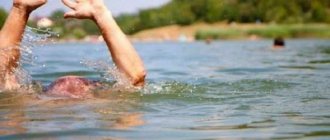When spending leisure time near bodies of water, remember the danger they pose for the unwary swimmer. After all, swimming and diving can bring both pleasant memories and terrible life experiences. Fortunately, if you follow the safety rules on water, the chance of such emergency incidents is extremely small.
Common causes of drowning are hypothermia or overheating, which can cause loss of consciousness and subsequent filling of the lungs with water. Increases the risk of convulsions during hypothermia. The possibility of disorientation of the victim due to alcohol intoxication, which leads to a weakening of the ability to rationally assess his condition, cannot be ruled out. At the moment when the victim loses consciousness, the body does not stop breathing to maintain vitality. Therefore, an unconscious person's automatic attempt to breathe will result in the airways and lungs filling with water. This is fraught with fatal consequences in a situation where first aid for drowning was not provided or it was provided incorrectly.
First aid for drowning - what to do?
The main threat that leads to a tragic outcome is the ingress of fluid into the respiratory tract and lungs. The volume of liquid ingested is directly related to the time a person spent under water.
First aid for drowning will be relevant when you are under water for three minutes.
After passing the five-minute mark, the chances of survival tend to zero.
The main thing to remember before providing first aid for drowning is that you should act carefully, calmly and calmly. It is natural that when a drowning person panics, he is fighting for his life. And it’s a completely different matter when the rescuer panics. An important point that will affect the likelihood of success is the presence of swimming skills. If you have completed basic training at school or university in physical education classes, then these will be quite enough (Figure 1). Be prepared for the fact that a drowning person may accidentally pull you under the water, hugging you tightly, because he is in a state of mortal panic. First aid techniques for drowning will vary depending on the amount of water in the lungs.
Figure 1. When rescuing a drowning person, be careful: the drowning person can drag you to the bottom too
There are various types of drowning, first aid for which will require special skill, and the primary ones are:
- First aid for drowning in water will be most effective if during its implementation the chance of salvation is objectively high. For an unqualified rescuer, it will only work if a person floundering in the water was noticed immediately. Help him stabilize on the water, take a breath, cough up water and come to his senses. In situations where the victim’s lungs are filled with water, a forced march awaits you with the body at the ready. Swim up from behind and grab him by the armpits or, in extreme cases, by the hair. Turn the drowning person onto his back and swim to the shore, avoiding attempts to grab you;
- First aid for someone drowned on land is a life-saving straw for someone who was in the water for more than three minutes and was quickly brought to shore in an unconscious state. In this scenario, it is necessary to begin providing first aid for drowning as quickly as possible. It will consist of a procedure to restore the pulse, expel water from the lungs and restore spontaneous breathing.
First aid for drowning
- As soon as the victim is on the shore or on board the boat, begin providing assistance. Regardless of the severity of the victim’s condition, it is necessary to call an ambulance.
- If it is possible to remove a conscious person from the water, first aid is to most effectively remove water from the respiratory tract and stomach, calm and warm the victim. To do this, the rescuer helps the person roll over onto his stomach, bends him over his thigh, taps him on the back, helping him clear his throat. The person is freed from wet clothes, wiped dry, and wrapped up. They give you a warm drink and send you to the hospital as soon as possible.
- If a drowning person is unconscious, do not waste time determining the stage and type of drowning or calculating the time spent under water. The effectiveness of rescue measures largely depends on the efficiency of your actions. First aid in this case is provided according to a single algorithm:
- Quickly turn the person over onto their stomach, face down, and place your own thigh or knee under the stomach. With your free hand, try to open the victim’s mouth and press with your fingers on the root of the tongue. So with one action you achieve three effects at once:
- help clear the airways from water, sand and other foreign objects;
- stimulate the respiratory center;
- assess the condition of the person being rescued.
- In the first case, a large amount of water pours out of the mouth, a gag reflex occurs, coughing and breathing movements occur, and the person regains consciousness.
- In the second case, no water comes from the respiratory tract and there is no gag reflex. Without wasting a second, turn the victim onto his back and begin artificial respiration.
- If there is no heartbeat, alternate artificial respiration with chest compressions.
- Signs of revival will be pinking of the skin, the appearance of a cough reflex, attempts at spontaneous breathing, pulse and movements.
Primary or “wet” drowning
When, with the last of his strength, a person grasping at the opportunity to escape flounders in panic and tries to stay on the surface, he swallows huge volumes of liquid. By filling the space inside the alveoli, water does not allow oxygen to penetrate into the blood, thus disrupting the natural oxygen cycle in the body. This causes a state of oxygen deprivation called hypoxia, which can cause the skin to turn blue. Also noticeable signs will be swollen veins in the neck and pink foam from the throat.
Figure 2. After you have pulled the drowning person out of the water, clean his mouth from algae and other dirt, and then proceed to remove fluid from the stomach and respiratory tract
To avoid death, you need to know how to provide first aid to a drowning person (Figure 2):
- Spending extra time checking your pulse can play a cruel joke, so it’s better to skip this moment;
- Begin the procedure of cleansing the stomach of excess fluid;
- Throw the adult belly down over a thigh or bench, then press firmly onto the back. A small child can be turned upside down and shaken;
- Clean the oral cavity from sand and algae;
- Next, trigger the gag reflex by sticking two fingers deep into the throat and pressing on the tongue;
- If vomiting occurs, you can relax, because this indicates the presence of a pulse;
- If the gag reflex does not follow, you need to start the procedure of chest compressions;
- When the moment has come to remove water from the lungs, grab the person by the armpits from behind and begin to squeeze the sides of the chest. At the same time, insert two fingers into the drowned man’s throat;
- As soon as the victim stops coughing up liquid, turn him on his side and cover him with something warm: a blanket, a towel, outerwear.
First aid for drowning, asphyxia
Drowning is a form of asphyxia that develops as a result of the closure of the airways by a liquid medium.
For drowning, it is absolutely not necessary that the body or head be completely immersed in a liquid medium. Most often, the process of drowning occurs very quickly (within 3 to 5 minutes).
The cessation of gas exchange with the air occurs as a result of:
— liquid entering the respiratory tract ( true drowning );
- laryngospasm ( asphyxial drowning);
- reflex cardiac arrest (“syncope” drowning).
True drowning. Occurs in 75–95% of water accidents. With this type of drowning, water does not enter the lungs immediately, but after a short breath-hold. As a result of the fear of death, mental agitation occurs, which leads to a sharp increase and deepening of breathing, involuntary breaths appear under water and water enters the lungs in large quantities. When the victim is finally immersed in water, a rapid loss of consciousness occurs and soon breathing stops. After breathing stops, cardiac activity continues for several minutes, thanks to which drowned people removed from the water shortly after immersion can be quickly revived. A victim of true drowning is purple-blue in color (“purple-blue” death), with a pronounced disturbance in the rhythm of breathing, white-gray or bloody foam is released from the mouth and nose, the veins of the neck and limbs are swollen. Pathogenesis
: When drowning in fresh water, water quickly penetrates from the alveoli into the blood, causing hemolysis of red blood cells, an increase in circulating blood volume and other changes leading to acute renal failure. Sea water, which is a hyperosmolar liquid in relation to blood, promotes the flow of the liquid part of the blood into the alveoli. Pulmonary edema develops, accompanied by hypovolemia, blood thickening and other changes.
Asphyxial drowning occurs in 5–20% of cases. In response to the initial entry of water into the upper respiratory tract, a reflex spasm of the glottis (laryngospasm) and false breaths occur, during which water does not enter the lungs. This type of drowning develops in people who have a pronounced inhibition of the central nervous system before diving into water, for example, with alcohol intoxication, traumatic brain injury, stress, hitting their head when diving into water, in people suffering from epilepsy, with impaired cerebral circulation. Pathogenesis: with a closed glottis, false breaths lead to the formation of persistent fluffy foam from blood plasma proteins, which first fills the lower airways, and then, after opening the glottis, exits into the pharynx and oral cavity. At this time, water in large quantities can be swallowed into the stomach. Victims of this type of drowning appear blue and white or faint pink fine bubble (“fluffy”) foam is released from the upper respiratory tract. Clinical death with asphyxial drowning occurs somewhat later compared to true drowning (after 4–6 minutes), especially at low water temperatures.
Syncopal drowning occurs in 10–15% of cases. Occurs during reflex cardiac and respiratory arrest (during emotional stress, immersion in cold water - “ice” shock, cold water getting into the ear and upper respiratory tract). Clinical death occurs quickly and the lungs do not have time to fill with water, no fluid is released from the respiratory tract, the skin is sharply pale due to pronounced spasm of the peripheral vessels (“sinking whites”), the pupils are dilated, and there is no heartbeat. When drowning in cold water, the duration of clinical death is up to 30 minutes.
First aid. When rescuing a drowning person, you need to swim up to him from behind and, grabbing him by the hair or under the armpits, turn him face up.
The rescuer immediately, after removing the head from the water, performs artificial ventilation using the mouth-to-mouth or mouth-to-nose method. It should be noted that artificial ventilation using known methods should be started as soon as possible - while still on the water, in shallow water. A few breaths in the water and in shallow water can significantly increase the chances of a successful revival. Resuscitation measures continue when transporting the victim on watercraft. In case of true drowning, you should not waste time clearing all the airways from the liquid that has entered them. It is enough to free the upper respiratory tract from foreign contents (sand, silt, etc.) and begin cardiopulmonary resuscitation.
The nature of the violations and the degree of their severity depends on the amount of water that enters the respiratory tract, as well as its characteristics (fresh, sea, chlorinated) and pollution.
In case of drowning in fresh water, with a picture of a “white” death, it is necessary to quickly perform an oral toilet and immediately provide artificial ventilation and closed cardiac massage. Attempts to “pour water” out of the lungs are pointless and involve the loss of precious seconds.
For someone who has drowned in sea water, it is necessary to clear the airways of water and foam using gauze or a handkerchief. In order to remove fluid from the airways, it is necessary to place the drowned man with his stomach down on the rescuer’s thigh, lower his head and, with sharp pushes, press with his palms on the subdiaphragmatic area. This technique allows you to change the position of the diaphragm, due to which water is “pushed” out of the respiratory tract. Then carefully remove the drowned man from the hip, turn him over and immediately begin artificial ventilation and external cardiac massage.
It must be remembered that there is a danger of premature termination of artificial ventilation in those who have been revived after drowning. The appearance of spontaneous breathing in them does not mean that normal gas exchange in the lungs has been restored, especially in conditions of the development of their edema.
With true and asphyxial drowning mechanisms, the time during which resuscitation can be carried out is 3-6 minutes, with syncope - 10-12 minutes. If the victim regains consciousness, measures should be taken to warm and calm him, remove wet clothes, intensively wipe him (massage), change him into dry underwear, and wrap him up. Give strong hot tea or coffee, 50 g alcohol or 25-30 drops of valerian, cordeamin or caffeine. All those who are revived after drowning are subject to further inpatient treatment, no matter how little time they were under water.
Asphyxial or “dry”
Pale skin and fine pink foam from the lungs are indicators of dry drowning. The reasons preceding this are severe relaxation of the nervous system in a state of alcoholic intoxication, or any other disturbances in the functioning of the central nervous system. “Dry” is a fairly common type, caused by an involuntary spasm of the glottis due to liquid entering it, causing irritation.
Figure 3. Scheme of manifestation of laryngospasm during “dry” drowning
By closing the entrance to the lungs, laryngospasm leads to suffocation due to oxygen deficiency (Figure 3). However, the liquid does not penetrate the lungs until the person loses consciousness and the relaxation phase sets in, making rescue many times easier. Therefore, you can skip the phase of squeezing fluid out of the lungs and immediately move on to more necessary procedures.
The first aid that should be provided to a drowned person will be very simple, but requires preliminary training or experience:
- Lay the victim stomach up on a hard surface. For example, on a hard wooden bed or concrete slabs;
- Begin the resuscitation procedure;
- Without bending your elbows, place your hands on the victim’s chest;
- Push with your entire body every half second;
- Tilt the victim's head back until an obtuse angle is formed between the chin and neck;
- Alternate compressions with artificial ventilation using the mouth-to-mouth principle (Figure 4);
- Pinch the patient's nose and take a sharp breath;
- Exhale sharply into his mouth and open his nose;
- Carry out the procedure at intervals of 4-5 seconds. The recommended frequency is 2 exhalations per 30 compressions;
- When a pulse appears and spontaneous breathing appears, you can calm down and provide further assistance: help the victim get to the nearest warm room for further warming with tea and a warm blanket.
Figure 4. First aid steps for dry drowning
Syncopal drowning
This type of drowning occurs due to reflex cardiac arrest, provoked by temperature shock caused by entering ice water from a hot environment. Intense physical activity, such as running, which heats up the body, will also be risk factors. Intoxication and overeating will also not be beneficial and will only increase the risk of drowning.
Figure 5. If you pulled a drowning person out of cold water, the chances of saving him are higher than saving him in the warm season
Visually, the victim will stop all actions and begin to drown due to the shutdown of all higher nervous activity and the absence of any motor skills. Therefore, it is necessary to dive for the drowning person as quickly as possible and try to pull him to shore.
First aid for drowning will consist of resuscitation procedures for artificial ventilation and chest compressions (Figure 5).
If this happened in icy water, then the chances of survival will increase. Due to the slowdown of all biological processes in a cold environment, including oxygen metabolism, this will allow the drowned person to be restored to their condition even after 10 minutes.
Secondary drowning
Quite a dangerous phenomenon due to its non-obviousness. It usually occurs after the primary one and carries a hidden threat that can only be detected by careful observation. The mechanism by which this phenomenon occurs is quite simple. After removing water from the lungs, some fluid may remain inside in the form of droplets, which will interfere with the proper functioning of the respiratory system. This will lead to a depletion of oxygen in the body and a subsequent lack of oxygen in the brain. In adults, this problem is solved by the body itself, but for children it poses an increased danger, since the area of their lungs is relatively smaller and any violation will lead to prolonged oxygen starvation. The secondary type of drowning can be detected over a time period from an hour to a day.
Figure 6. If these symptoms appear after drowning, call an ambulance immediately
Symptoms to look out for (Figure 6):
- Difficulty breathing;
- Prolonged cough that does not go away for several hours;
- Pain in the chest cavity;
- A slight temperature deviation from the norm;
- Sudden crippling fatigue accompanied by drowsiness;
- Impaired thinking abilities and odd behavior;
- Nausea and heaviness in the stomach.
When faced with these symptoms, it is necessary to call an ambulance, but it may not always arrive on time (Figure 7).
Figure 7. When calling an ambulance, do not rely only on its quick arrival, provide all possible CORRECT first aid
When you are pressed for time, do the following:
- Sit down and ask your child to lie on your back, feet up;
- Grab your hips with your hands and secure them on your shoulders;
- Then stand up straight and ask the child to cough while shaking him.
First aid for drowning: algorithm of actions
When faced with an emergency on the water, it is necessary to follow a certain algorithm that will help save lives.
First aid for drowning briefly point by point in chronological order:
- Ask someone to call an ambulance;
- Pull the body out of the water onto the shore;
- Don't waste time checking your pulse;
- Immediately begin resuscitation procedures;
- Follow the instructions for each scenario;
- Help the victim come to his senses;
- Wait for paramedics to arrive.
By following the above algorithms and remaining calm, you will be able to determine what type of drowning you are faced with, after which you can easily provide first aid that will save someone else’s life.
Emergency assistance for drowning
When an accident occurs, you need to act quickly. If there is no professional rescuer or medical worker nearby, then first aid for drowning should be provided by others. The following steps should be followed:
- Wrap your finger in a soft cloth and use it to clean the rescued person’s mouth.
- If there is fluid in the lungs, you need to put the person on his knee with his stomach down, lower his head, and make several blows between the shoulder blades.
- If necessary, perform artificial respiration and cardiac massage. It is very important not to put too much pressure on your chest to avoid breaking your ribs.
- When a person wakes up, you should free him from wet clothes, wrap him in a towel, and let him warm up.
Difference between sea and fresh water for drowning
An accident can occur in various water sources (sea, river, swimming pool), but drowning in fresh water is different from immersion in a salty environment. What is the difference? Inhaling sea fluid is not as dangerous and has a better prognosis. The high salt concentration prevents water from entering the lung tissue. However, the blood thickens, causing pressure on the circulatory system. Complete cardiac arrest occurs within 8-10 minutes, but during this time it is possible to resuscitate a drowning person.
As for drowning in fresh water, the process is more complicated. When fluid enters the cells of the lungs, they swell and some cells burst. Fresh water can be absorbed into the blood, making it thinner. Capillaries rupture, which impairs cardiac function. Ventricular fibrillation and cardiac arrest occur. This whole process takes a few minutes, so death occurs much faster in fresh water.
- Alaminol for manicure tools
- Sesame seeds - benefits and harms and how to take black and white sesame seeds
- Keratosis of the skin - causes, symptoms and treatment with medications and folk remedies
First aid on the water
A specially trained person must be involved in rescuing a drowning person. However, it is not always nearby, or several people may drown in the water. Any vacationer who knows how to swim well can provide first aid. To save someone's life, you should use the following algorithm:
- You need to gradually approach the victim from behind, dive and cover the solar plexus, taking the drowning person by the right hand.
- Swim to the shore on your back, row with your right hand.
- It is important to ensure that the victim's head is above the water and that he does not swallow any liquid.
- On the shore, you should put the person on his stomach and provide first aid.










